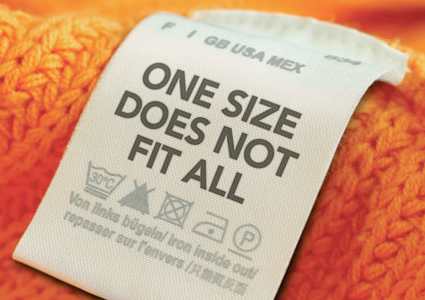
Whether you’re a business, organization or individual, keeping your ROI (Return On Investment) in mind is critical and having a firm grasp on the entire process will help ensure you get the most ‘bang for your buck’.
Here are 6 factors to keep in mind BEFORE having your shirts printed. These tips can help you achieve the maximum desired impact and make your investment worthwhile.
Contents
Know your goals
While this may be business 101, you’ll be surprised how many times this step is either overlooked or not given as much thought and definition as it should. These goals will become the foundation of your entire business and define your marketing plan. Without any goals listed, there is no way to gauge the success (or failure) of your campaign and track your ROI (Return On Investment).
Read this article from Forbes about setting business goals here.
It’s important you constantly keep these goals in mind when going through both the conceptual and design phase.
Know your message
You not only need to know your message and have it defined, but you must also be able to effectively ‘speak’ to your audience and grab their attention.
The design of your shirt should accurately and easily display your message. Here are some general things to keep in mind:
• Keep it simple
• Accentuate the important aspects of your message in your design
• Ensure the design flows together
• Avoid industry rhetoric that may confuse people
This may seem like overkill for what you may consider a ‘simple’ t-shirt, but a shirt with a great design can be a very effective promotional tool within your overall marketing strategy.
Be unique
Don’t fall into the trap of ‘one size fits all’ mentality. It boggles us when companies use the same exact design for all their shirts, no matter what the shirt will be used for. A design that works for your employee’s shirts may not be the best design for a promotional giveaway or an event your company is participating in.

Know your audience

By knowing your target demographic, you can fine-tune your custom apparel products to best achieve your goals. This applies both to concept creation as well as choosing the best garment for the job.
Some questions to ask yourself:
• What will appeal to my target audience?
• Are there specific colors that work better than others?
• What fonts will work best?
• Should the design have nice curves or be more “straight lined” style?
• Where will the shirt be displayed? Is it for a local event with several thousand people or for a convention where you’ll give these out at your booth?
Having a design that is laser targeted to appeal to your audience will help not only get your message across but also build brand loyalty.
An article we’ve directed people to help them get a firm grasp of their target marketing is at this link.
Know your colors
Colors are the fun part of the design process. A shirt with beautiful colors and blends can take a great shirt and make it even greater.
While having a 10+ color shirt is cool and a definite ego booster in conversation, in most cases, this is total overkill. While there may be no way around it for some designs, most of the time the best philosophy for your design is to KISS – Keep It Simple Stupid.
Don’t over complicate things
While colors are the meat and potatoes of your design, don’t overdo it.
Remember, printing on a shirt is different than printing something on paper (like a brochure, billboard, flyer, etc). For most designs, 9 colors is the most you’ll need. To help bring costs down, we can drop the colors even more through artwork manipulation and still have a great looking product – sometimes even more crisp and vibrant than the original design.
Know your graphic design company
Most people in the industry would say to choose your graphic designer wisely – and that’s true, to a point. As you know, we like to take things up a notch.
Graphic artists are just that – graphic artists. Most are very exceptional at their craft, however, not all graphic artists are advertising and branding specialists. In fact, most aren’t. They may have some experience in marketing and advertising but that’s not their “specialty.” And most custom apparel shops don’t have a marketing and advertising professional working with them.
We’ve taken it one step further and we have advertising and marketing professionals to help in your design process. This extra set of eyes looking at things from a marketing and advertising perspective can help bring your design to the next level.
In this scene from Indiana Jones And The Last Crusade, to save his father, Indiana Jones must choose the Holy Grail from several differences choices. After seeing someone before him die from picking the wrong one (to which the guard told them he had ‘chosen poorly’), Indiana Jones uses his logic and education to ultimately choose the right one. He is then congratulated by the guard who tells him he has ‘chosen wisely’.
The same applies when choosing the company who will be printing your shirts. Do they help and give you as many resources as possible to help achieve your goals? Do they have those “extras” like marketing and advertising professionals working on your project?
Don’t settle
Graphic artists and apparel companies are busy and, as bad as it sounds, sometimes get overwhelmed by the sheer amount of work they need to accomplish. This overload sometimes leads to them trying to “rush” to get your order done.
Artwork design and approval are often the cause of delays in the shirt printing process – and custom apparel companies know this. They try to combat this by “selling” you on a design simply because they want to get your artwork approved, order printed and out the door. Well, that means you don’t get the absolute best product you can and that’s not fair to you.
However, keep in mind that just because the artist or company is trying to “steer” you in one direction, it doesn’t necessarily mean they don’t care or they’re trying to rush through your order. It could be that we know the industry and what will look best on a shirt so we’re trying to save you from making costly mistakes. We’ve had to do this several times and our clients are thankful to us for it.
How can you tell the difference if they’re rushing you or legitimately trying to help?
It’s tricky, but this is where communication comes in. Ask them about the reasons why they’re telling you this. Check to see if they have samples of what they’re talking about.
There are several different factors that come into play for each individual design so at the end of the day, educate yourself as best you can, do your research and trust your gut.
That’s it. We hope you now know some things about making an impact with your shirt design.
Have any questions? Let us know in the comment section below.

